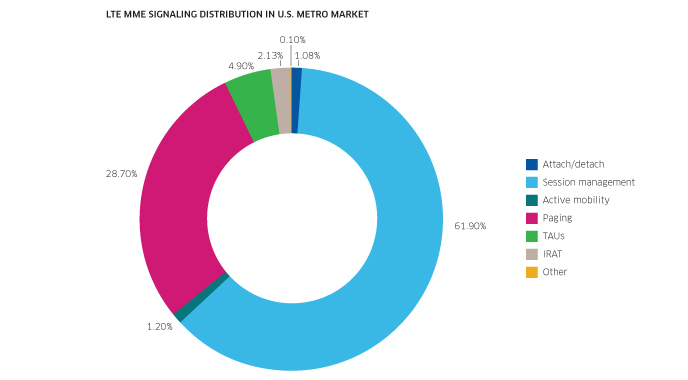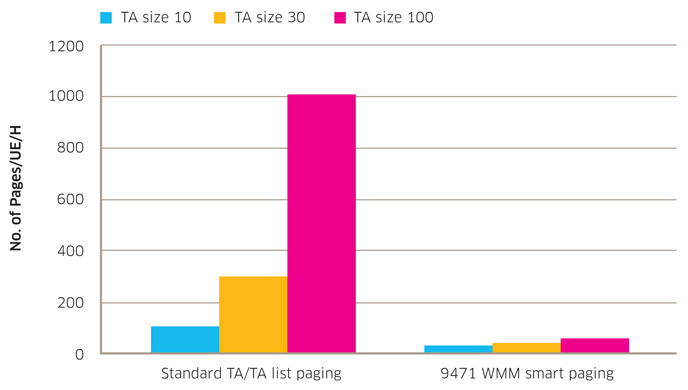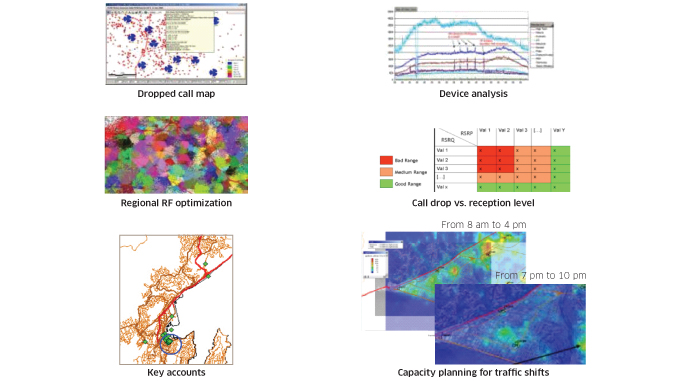David Nowoswiat, Gordon Milliken, Alcatel-Lucent
In the early stage of large-scale LTE network deployment, the signaling volume of the packet core network is significantly higher than the existing 2G/3G. This is partly due to the flattened, all-IP architecture of LTE, that is, the macro and micro stations are directly connected to a dedicated control plane unit MME in the EPC. From the analysis of several large LTE network deployment field data, the MME can bear a continuous signaling load. Under normal conditions, each user equipment (UE) has 500-800 messages during the busy period. In extreme cases, Up to 1500 messages per hour per user.
The increase in core network signaling can also be attributed to the overall increase in LTE users' use of the network. In some large cities in the United States that use LTE, the peak of network usage is that each UE reaches 45 service requests per hour when busy. As LTE use will become more and more common, EPC signaling will continue to rise. If the rise of signaling is not properly managed, there will be problems of control plane congestion and signaling storm.
Therefore, when the mobile network operator (MNO) deploys and develops LTE, they must take some measures to ensure that their core control plane network can support the increase of the expected signaling. Specifically, mobile network operators need to deploy a carrier-grade, next-generation MME/service GPRS support node (SGSN) platform that not only has high capacity, scalability, and CPU processing performance, but also has intelligent management. Service capabilities to fully reduce core network signaling. Two aspects of improving signalling efficiency in the MME are paging and tracking area (TA) management.
Paging and TA Management Challenges
Paging management sends signaling messages to the eNodeB and the UE in the MME. Paging is required to determine the position in the network when the UE is in an idle state, and the idle state of the UE makes it possible to determine a more exact location in the network. The paging management method used by the network is:
It is required to establish a non-access stratum (NAS) signaling connection between the MME and the UE to support the network service request. After the network fails, the UE is prompted to reattach itself to the network. Start a mobile circuit switched fallback (CSFB) mechanism.
In LTE, the signaling traffic generated by the MME paging the UE is of concern. Figure 1 shows field data from an LTE service provider in a large US city. The results show that paging accounts for more than 28% of the MME total signaling load. Thus, looking for a way to reduce MME paging will help MNOS. (Mobile Network Operators) Reduce the overall network signaling load and manage MME costs.

In the Evolved Terrestrial Radio Access Network (E-UTRAN), one TA represents a group of consecutive cells. It is usually when the UE moves in the network in idle mode, which is tracked and located by the MME. A TA list is composed of a group of adjacent TAs, managed by the MME and periodically sent to the UE. The MME sends a paging message to the cell, and this cell is included in any TA or registered UE's TA list. The use of a Tracking Area Update (TAU) method occurs only when the UE crosses the TA border into another TA, and this TA is not in its TA list, or when the periodic TAU timer expires, the tracking area is updated The (TAU) method will also be used.
The TAU method can generate a lot of signalling if the UE moves on a TAs boundary that does not all belong to its TA list, especially when the TA size is large (eg 50-100 eNodeBs in a TA). This is referred to as a "handover" effect because multiple MMEs register, and it occurs when the UE moves at the TA boundary, generating additional TAU signaling.
In addition to generating a high amount of signaling, the method of paging and TAU signaling is an important power consumption for the UE battery. Therefore, careful design of TAs is required so that they are neither too large to minimize the paging volume nor too small to prevent and avoid frequent movements at the border of the TA.
Intelligent paging and TA management with reduced signaling
The next generation MME/SGSN, such as the Alcatel-Lucent 9471 Wireless Mobile Manager (WMM), allows mobile network operators to customize the MME paging mechanism for various types of services. This helps mobile network operators reduce paging while still meeting the end user's desired quality experience for all types of services.
The 9471WMM paging mechanism supports the following configurable parameters:
The type of service paging The number of paging applications The time between paging applications The paging method for each application
The paging mechanism is fully compliant with the 3rd Generation Partnership Project (3GPP) standards and can be deployed on any vendor's wireless node eNodeB on the network.
As shown in FIG. 2 , the intelligent paging and TA functions can reduce signaling in basic TA and TA list paging methods, and can reach 80% or more depending on TA size.

Figure 2 Smart paging significantly reduces the amount of signaling
The dynamic TA list management technology can further reduce the MME signaling load. These techniques optimize the number of TAs in the UE's TA list when the UE moves in the mobile network. When it is detected that the UE movement is in the loop mode, the TAs can be automatically added from the UE registration TA list through the registered TA boundary of 2 or 3 (FIG. 3). By continuously updating and optimizing the TA list of the UE, a smaller TAU request is generated, which reduces handover at the TA boundary.

Figure 3 Dynamic TA list management further reduces MME signaling load
The TAU method also shortens the UE's battery life - in current smart phones, each TAU method consumes about 10 milliwatts of power. Table 1 shows the UE power consumption and battery life savings of the smartphone compared to using the basic TA list management function using the dynamic TA management function. This TAU method power estimation includes aspects such as TAU messages and attachment of eNodeBs. One LTE smartphone for power consumption comparison is:
800 mW for launch 500 mW for reception 5.5 mW for idle state

Table 1: Dynamic TA List Management Reduces Smartphone Battery Consumption
Table 1 shows that the dynamic TA list management technology consumes less UE battery compared to the battery life of a smartphone, up to several hours, depending on the TA size and the user's smartphone usage.
Analyze Optimized LTE Radio and Core Networks
For LTE and its all-IP architecture, a new set of analysis methods is needed to maintain network operation. Using traditional radio access network (RAN) management tools is time consuming and resource-consuming. It has some drawbacks:
The drive test only provides a sample of network coverage, which is also controlled and constrained by time. Business measures aggregate all user data. This aggregation is useful for detecting hardware failures, but it cannot detect individual customers' performance problems. Use call tracking to specifically resolve customer complaints. When a test failure occurs, the user can be required to make a test call. But this is not always feasible. It also requires a lot of time and sometimes it may require a costly on-site measurement and tracking in order to replicate the user's behavior.
Diagnostic tools, such as Alcatel-Lucent's package tool for per-call measurement data (PCMD) for LTE networks, provide a comprehensive record of UE, eNodeB, and MME call procedures that differ from traditional RAN performance diagnostic tools. They use the user's mobile devices to collect a rich set of terminal and network signaling and bearer data. Unlike call tracking, all UE PCMD calling procedures are captured. This provides a more accurate view of the network's end-user experience. In addition, because end-user mobile devices are used to collect data, the need to drive tests is significantly reduced.

Figure 4: Diagnostic tools, such as PCMD, bring valuable analysis to LTE networks
The benefits of improved network analysis for MSP:
Customer Service: Can quickly identify network coverage and terminal problems, provide a quick response that can improve customer satisfaction, and reduce the duration of failed call maintenance. Operation: Have the data analysis report required for continuous improvement and quality management. For example, end-user device data, coverage holes, dropped calls, and battery performance problems can all be identified. Key performance indicators (KPIs) for improvement purposes can also be established. Engineering and network planning: Business model analysis methods and accurate radio frequency (RF) measurements can be used to predict and verify coverage requirements. This information also facilitates RF coverage and capacity planning and use, helping to reduce capital investment and adopting more targeted RAN investments.
New technologies require new network capabilities
With the expansion and competition of the "always-on" applications and business scope of smart phones and tablets, and the rapid development of LTE, MSPs must consider how they will solve the signaling challenge.
The high performance and scalable SGSN and MME support the expected signaling volume, provide intelligent paging and TA management technologies, and help MSPS to solve the LTE signaling challenge:
Reducing the amount of signaling enables MSPs to support more MME users and postpone additional MME capital investment. Dynamic TA management ensures that the UE always has an optimized TA list, minimizing TAUs and extending UE battery life.
In addition, advanced diagnostics and troubleshooting tools help MSPs manage and support LTE networks. MSPs can solve customer problems faster, improve network performance and customer satisfaction, and reduce customer churn.
The development of LTE is a great investment for MSPs. Operators who first consider addressing the signaling challenge will be given a better position to recover their investment in the future.
Customized Reserch And Develop
A report on Lithium Iron Phosphate (LiFePO4) Battery Market has been added by Kenneth Research into its market research repository. The report provides an extensive analysis of the market by determining the relationship between the dependent and independent variables through correlation and regression for the forecast period, i.e., 2021 2025. The report on Lithium Iron Phosphate (LiFePO4) Battery Market further provides the supply and demand risks associated with the growth of the market, and consists of macro-economic indicators that are contributing to the market growth. The market is thriving on account of the growing trade on fuel worldwide, backed by the rising demand for energy from the end-users.
According to the statistics by the World Bank, exports of fuel increased from 12.91% of merchandise exports in 2001 to 14.25% of merchandise exports in 2018. Additionally, imports of fuel registered a growth by 1.28x between the years 2001 and 2018. In 2001, the import of fuel was 10.30% of merchandise exports whereas in 2018, it was 13.19% of merchandise exports. On the other hand, the increasing focus of the players in the energy and power industry to lower their cost of operations so as to enhance their profitability, is also anticipated to contribute to the market growth. The natural gas rents, which is defined as the difference between the total cost of production of natural gas and the production value at world prices, decreased significantly from 0.40% of GDP in 2001 to 0.18% of GDP in 2017. Alternatively, the oil rents, which increased from 1.09% of GDP in 2001 to 1.30% of GDP in 2019, portrays the need amongst the players to enhance their focus in reducing the cost of production of oil.
Customized Reserch And Develop,Lithium Ion Battery,Lithium Car Battery,Lithium Ion Battery Price,Lithium Battery Price
Shenzhen Zhifu New Energy Co., Ltd. , https://www.sunbeambattery.com